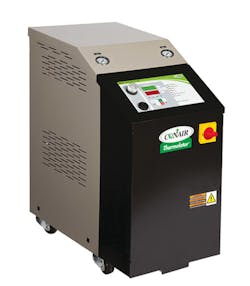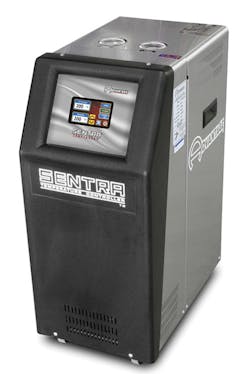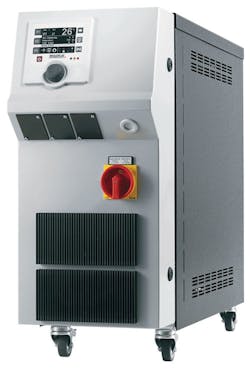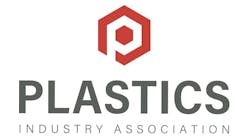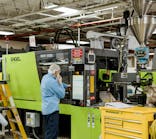Improvements To mold temperature control units (TCUs) have upgraded their water pumping, valve control and heater technologies to increase their efficiency, productivity and capability. Suppliers of mold TCUs have announced additional developments since NPE, held in March. This report also provides information about new enhancements to models included in Plastics Machinery Magazine's post-NPE article (see PMM, June 2015, story).
ENHANCED PERFORMANCE
AND CLEAN-ROOM READY
Conair Group Inc., Cranberry Township, Pa., has provided additional details regarding its upgraded TW series of pressurized water TCUs. The redesigned series will handle added pressure, increased water flow and higher temperature operation, as well as deliver up to 50 percent greater energy-efficiency. The upgrades, unveiled at NPE, will be commercially available in the first quarter of 2016, says Tim Miller, product manager for heat transfer at Conair.
The TW series upgrade will have a maximum water temperature of 300 degrees Fahrenheit for exit water, compared to 250 degrees Fahrenheit with previous designs. Several developments allow the new TW series to operate at the higher temperature range while extending the life of the pump, valve and cooling system, says Miller. They include new pump seals, a change in the pressure-relief valve setting and an adjustment to the pressure switch setting, as well as several proprietary piping changes. The higher temperature unit requires 70 pounds per square of inch (psi) of cooling water inlet pressure, which it is designed for, while the previous design required cooling water inlet pressure of 25 psi, says Miller.
The maximum heater capacities that can be incorporated into a standard-size cabinet have been doubled from 24 kilowatts (kW) to 48 kW. Prior designs offered the higher-capacity 48 kW heater, but the cabinet size had to be doubled, says Miller.
Conair redesigned the efficiency of the pump to deliver higher pressure and flow. "For instance, a three-quarter horsepower (hp) pump now produces 30 percent more pressure capability at the same given gallons per minute. It currently outperforms our older, 1 horsepower pump. This allows the user to downsize the pump for energy efficiency or gain greater pumping power in the same size unit," says Miller. The high efficiency of the new design has prompted Conair to consider developing a smaller 0.5 hp pump, which would likely perform at the same level as its older 0.75 hp pump while providing energy savings due to its size.
The upgraded TW series also features a heat exchanger that provides five times more surface area and capacity than the prior model. Conair also offers a high-capacity version with 10 times the heat exchanger surface area. To make the larger heat exchangers fit in the standard-size cabinet, which is unchanged, Conair changed the geometry in the castings. Previously, a single casting had a pump assembly on it that supported the heaters, and that in turn supported an insertion-type heat exchanger in the suction-side tank.
"We changed the geometry into two distinct castings, and have a smaller mixing tank on the suction side of the pump. This allows for a far larger heat exchanger to be incorporated," says Miller. The heat exchanger allows for the heat energy to pass between the supply water and process water without the two water flows contacting.
Conair currently offers several TW series models, including a Value (TW-V), Standard (TW-S) and Premium (TW-P). The versions have a broadened range of capabilities or options, yet each model can save a processor up to $1,100 per year in pumping energy costs.
Conair offers a choice of two pump sizes (0.75 hp and 2 hp) with the TW-V, which features magnetic contactor heater control with solenoid valve control.
The standard and premium versions of the TW series can be installed with pumps sized from 0.75 to 7.5 hp. These two versions use a magnetic contactor or mercury contactor for heater control. For the first time, solid-state heater controls are offered as an option.
A modulating flow control valve, designed as a floating, three-wire valve, is available for the standard and premium models. Miller says that the three-wire valve uses sensors and control signals to open and close the valve incrementally, unlike a solenoid valve that either fully opens or fully closes the valve. The modular valve control eliminates the possibility of water hammer. Water hammer is a problem that is caused when the valve closes abruptly, forcing the high- pressure water to bounce off the valve, potentially damaging valves and pipes. The control can hold the valve in a semi-open or semi-closed position while it zeros in on the ideal position that achieves set flow and temperature parameters, says Miller.
The upgraded TW series has also been incorporated into Conair's MedLine product range for use in clean-room applications, says Miller. The TW MedLine TCUs come with a quality and regulatory compliance package aligned with International Organization for Standardization (ISO) and Food and Drug Administration requirements. The MedLine TCUs are subjected to additional calibration steps, are labeled and certified for one year before they leave the factory.
TCU UPGRADES PUMP UP THE FLOW VOLUME
Thermal Care Inc., Niles, Ill., is launching its new RQE series of pressurized water TCUs. The series increases performance compared to the existing Aquatherm RQ line that it will eventually replace.
The new RQE models feature a re-engineered pump design that is 40 percent more energy-efficient than current models and delivers 70 percent higher water flow from the unit, says Bob Smith, director of product management. "Flow is directly related to cooling. In some cases, a molder can now get the same flow and pressure performance from the TCU with a smaller hp pump, which brings energy savings," says Smith.
Engineers at Thermal Care worked with different pump vendors to develop the higher performance pumps. The RQE series also features larger passageways for water flow in the integral heater and mixing tubes, reducing restrictions and resulting in less frictional loss in the unit, says Smith. The series' control system, solenoid valve technology, silicon carbide seals and heaters made from Incoloy are designed to handle the higher flow rates generated by the pump and passageway improvements. RQE incorporates Thermal Care's Seal Saver control technology, which extends the life of the pump seals by cooling the pump seals before stopping the unit. That prevents seal warping and minimizes frictional wear on the seals.
Thermal Care will offer several models featuring pump sizes ranging from 0.75 hp to 10 hp. (The RQ line's maximum capacity is 7.5 hp.) The heating capacity of the new RQE series also is wider than the RQ line, ranging up to 48 kW. (The RQ line goes up to 24 kW). The RQE line operates in a temperature range from approximately 50 to 250 degrees Fahrenheit. A 0.75-hp unit provides a flow rate of about 50 gallons per minute while the 10-hp pump delivers roughly 150 gallons per minute, says Smith.
For the first time, solid-state heater contactors are offered as an off-the-shelf option to mechanical contacts. They extend the life of the heater contactor for high-heat applications, says Smith.
LOWER COST, HIGHER EFFICIENCY TCU
Advantage Engineering Inc., Greenwood, Ind., introduced its new G series control for its Sentra line of water-temperature controllers, designed as a less costly but just as capable version of its Temptender T Series controller, which was introduced at NPE. The new G series controller is the replacement for the current LE series controller, but with many more user features, including available display of flow rate, says President Jon Gunderson.
The current G series and Temptender controllers feature Advantage's Advanced Valve Technology (AVT) which incorporates a modulating valve rather than a solenoid valve for cooling media control. Pump sizes from 0.75 to 7.5 horsepower are available with pump flow rates from 35 to 100 gallons per minute. Heater capacity from 10 to 34 kW is offered, and the TCU can deliver water from 30 to 250F (with an option to go to 300F). The G series will feature a new liquid crystal display screen, replacing older legacy controls with more powerful, user friendly graphics-based controls, says Gunderson. Molders also have an option to upgrade the controller of an existing LE series with the new G series controller.
The G series has an expanded range of standard features compared to the LE line, including an integral audible alarm, ability to run mold purge and adjustable start-up vent sequencing. The unit has a pump seal cooling feature and now incorporates several communication interfaces such as Modbus RTU and SPI protocols within the machine for remote machine monitoring and control, says Gunderson.
Advantage says the new Temptender full-color touch-screen microprocessor control for the Sentra line, introduced at NPE as a replacement of the HE control, has been commercially available since the summer. The controller features a 5-inch display with more than 15 screens for process setup, operation and monitoring.
The Sentra system preheats process water by engaging the electrical immersion heater of the unit and recirculating the water in the system. Sentra models can be made with heaters with capacities from 10 to 34 kW, pumps sized from 0.75 to 7.5 hp and water flow rates from 35 to 100 gallons per minute. The Temptender controller is the high-end controller in the Sentra line, while the new G series is considered the mid-level model, says Gunderson.
TECHNIQUE FOR RAPID HEATING,COOLING OF THE MOLD
Regloplas Corp., St. Joseph, Mich., developed a new, more flexible technique for molders seeking a way to rapidly heat and cool the mold. Using a rapid heating/rapid cooling approach requires warm water in the mold channels — which encourages better flow of molten polymer into the cavity — and then a rapid switchover to cooler water for part cooling. This is accomplished either by tying two separate water TCUs together with a valve station that alternates the water flow into the mold, or with a TCU that incorporates two separate water circuits, says Kip Petrykowski, director of national sales for dynamic temperature and composites.
Regloplas currently offers a switching mechanism (valve station) that allows for rapid heating/rapid cooling; however, the earlier design of its rapid heating/rapid cooling system was limited. "A molder had to dedicate one of the units as the cold-water circuit and the other as the hot-water circuit, and that relationship was permanent and could not be violated [switched] because the hot unit managed the pressure to the mold," says Petrykowski.
Regloplas now has upgraded the functionality of the valve station so that it controls the pressure to the mold, enabling the molder to use either TCU at any time as the hot or cold circuit. "The pressure and flow balancing takes place in the valve station," says Petrykowski. Regloplas developed algorithms in its controller technology that bring the higher functionality to the valve station. The new functionality better allows molders who have combined the two TCUs for rapid heating/rapid cooling to separate the units for individual use on separate applications. Processors can combine the units for rapid heating/rapid cooling later without any concerns.
Regloplas also has developed new pump and control options for its pressurized water (P series) of TCUs. The company has developed variable frequency drives (VFDs) that will allow units with small pump sizes to operate at the same flow rates as a larger pump by increasing the pump's revolutions per minute in an efficient and reliable manner. Users will be able to set the temperature differential between the supply line water and return flow water, and the VFD will operate the electrical pumps to maintain that setting. The new development is scheduled for release this month.
Regloplas also is developing a new touch-screen control panel for use with its P series of TCU, as an alternative to its standard knob-type push-and-rotate controller. The panel will allow for the display of additional processing information on a single screen, and promote easier access to features and functions. Output data can be transmitted to a PC or data-collection device and incorporated into production data.
Regloplas also expanded its P series of TCUs with the new P200MD model, a dual TCU design, in which two TCUs are mated onto a single chassis. It is designed for use with injection molds, extruders and mixers, and features Regloplas' magnetic drive pumps, patented SK low-scale cooling system and the company's battery technology that optimizes energy balance and energy consumption. The unit offers 8, 18 or 36 kW heating capacity and water temperature up to 392 degrees Fahrenheit, a 1.34 hp or 2.01 hp pump, flow rates of 16 or 26 gallons per minute, and pump pressure up to 108 psi.
Mikell Knights, senior correspondent
Contact:
Advantage Engineering Inc., 317-887-0729, www.advantageengineering.com
Conair Group, 724-584-5500, www.conairgroup.com
Regloplas Corp., 269-428-1100, www.regloplasusa.com
Thermal Care Inc., 847-966-2260, www.thermalcare.com

